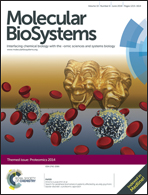Regulation of cell survival by the HIP-55 signaling network†
Abstract
HIP-55 (hematopoietic progenitor kinase 1 [HPK1]-interacting protein of 55 kDa) is the mammalian homologue of the yeast Abp1p. It contains a C-terminal Src homology 3 domain and an N-terminal actin depolymerization factor (ADF-H/C) domain. HIP-55 appears to be critical for organ development and immune response and is important for the regulation of the actin cytoskeleton through its interactions with F-actin and various cytoskeletal and cell signaling proteins. However, the function of HIP-55 in tumors remains unknown. Here, we found that HIP-55 is up-regulated or down-regulated in several types of tumor tissues in patients. Of these, lung cancer tissues had the highest expression of HIP-55. To gain full insight into the function of HIP-55 in lung cancer, microarray assay was performed using Affymetrix U133 Plus 2.0 expression arrays in both HIP-55 knockdown and scramble control A549 cells. The ingenuity pathway analysis tool was utilized to construct biological networks and analyze functions that might be associated with HIP-55. Functional analysis strongly suggested that HIP-55 may be involved in cancer cell survival and cell death, which was then confirmed by further experimentation. Experimental results showed that downregulation of HIP-55 decreased the viability and increased the apoptosis of A549 cells treated with the anticancer agent etoposide. Our data suggested that HIP-55 may be a newly discovered regulatory node in the growth signaling network and a new target for therapeutic interventions in proliferative disorders.


 Please wait while we load your content...
Please wait while we load your content...